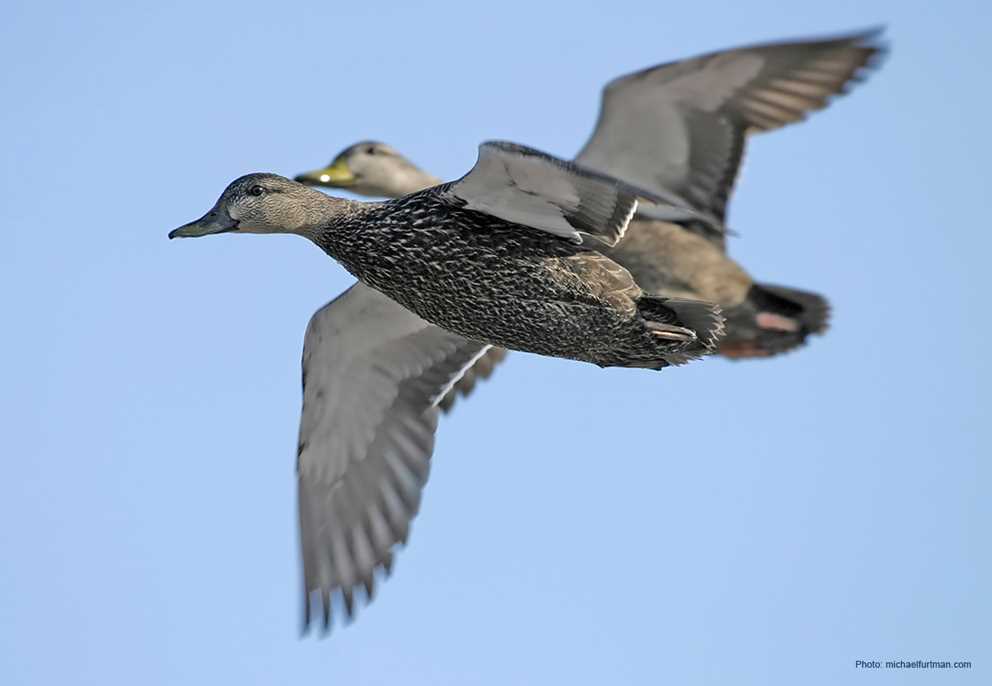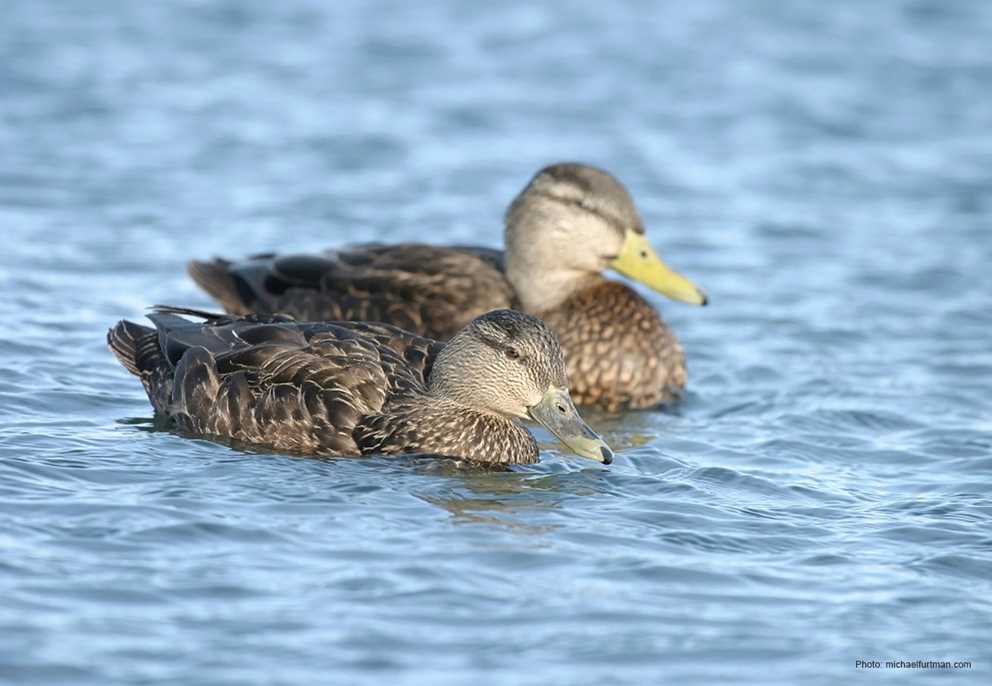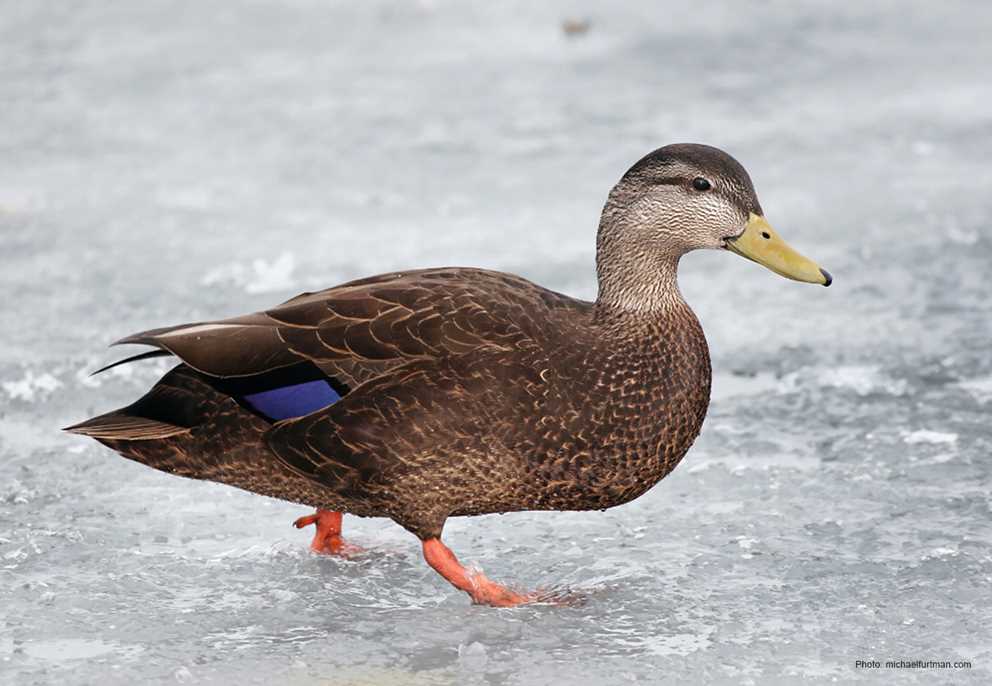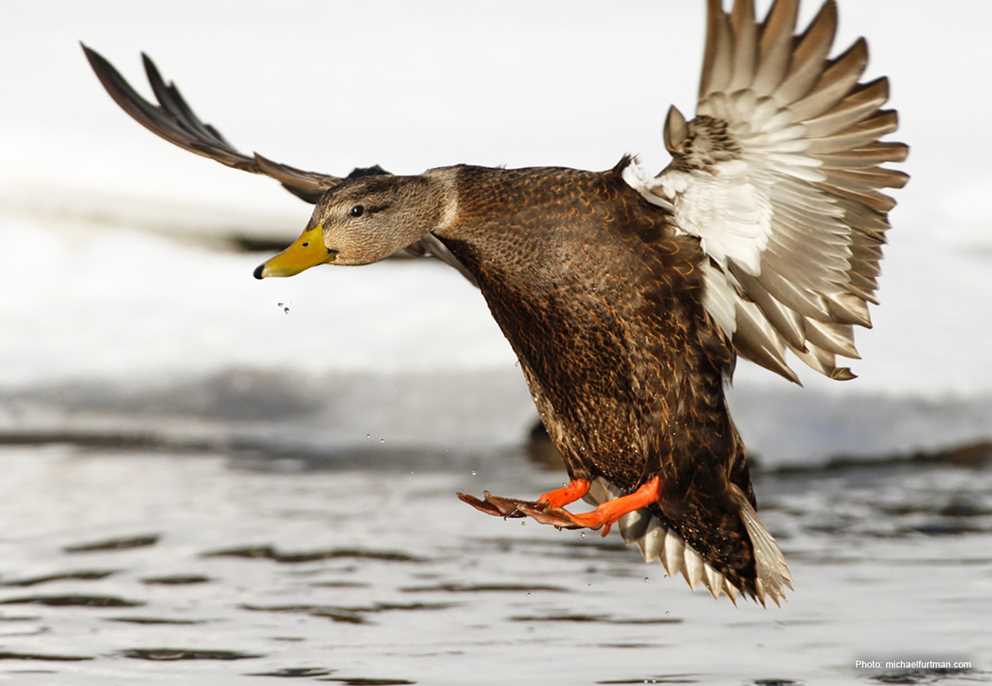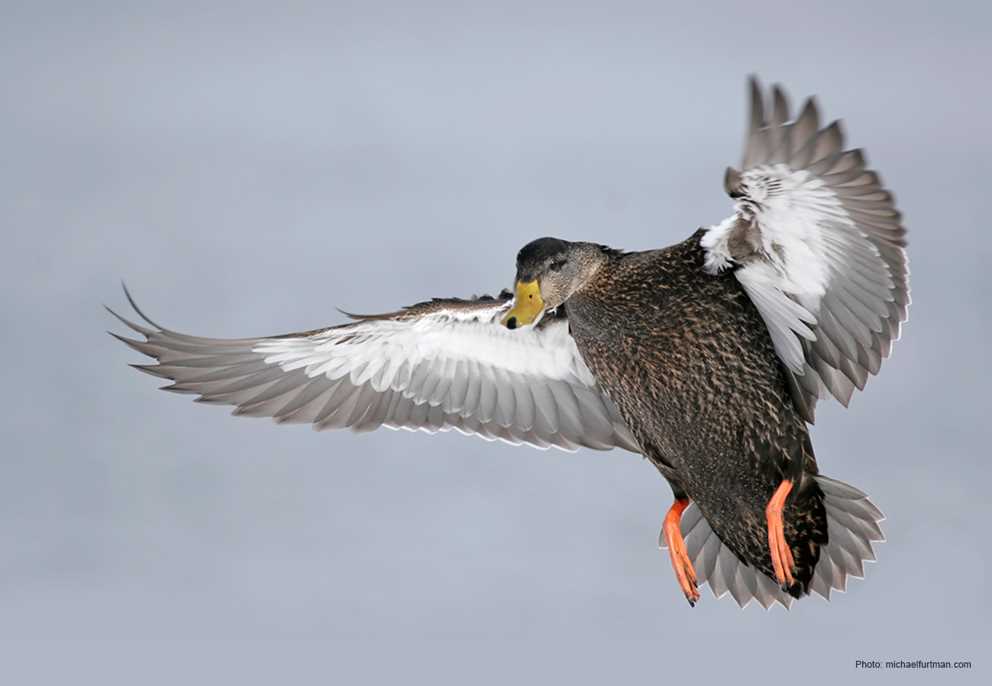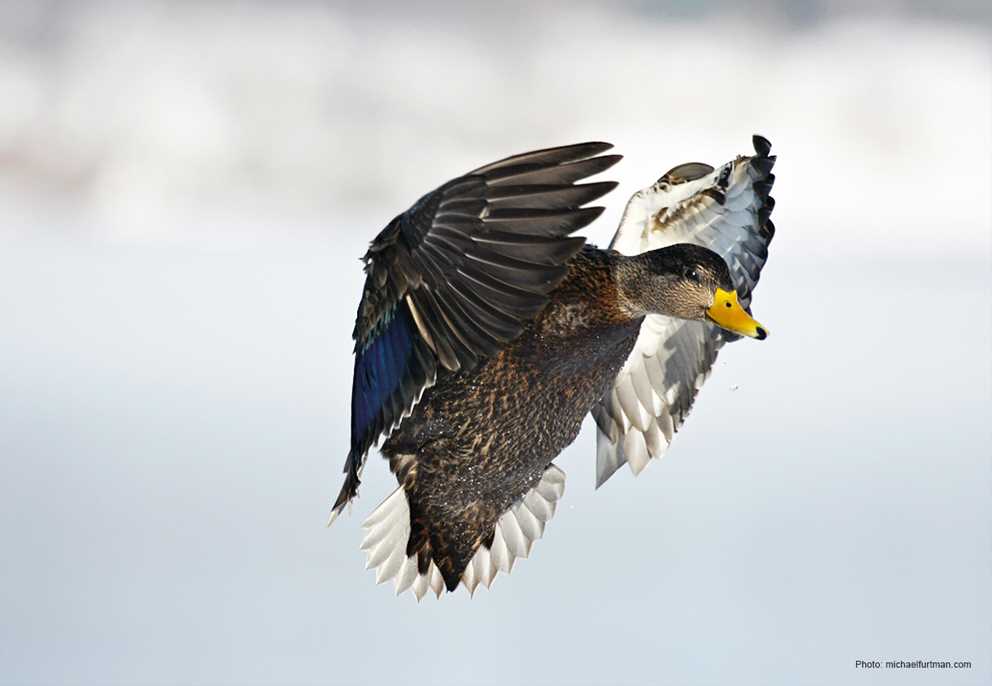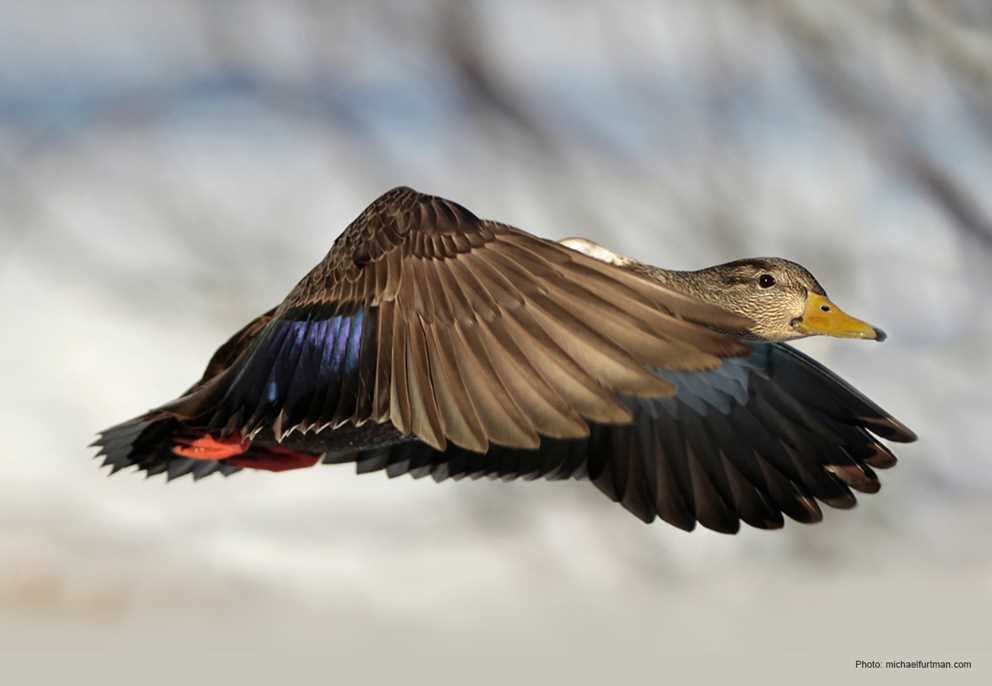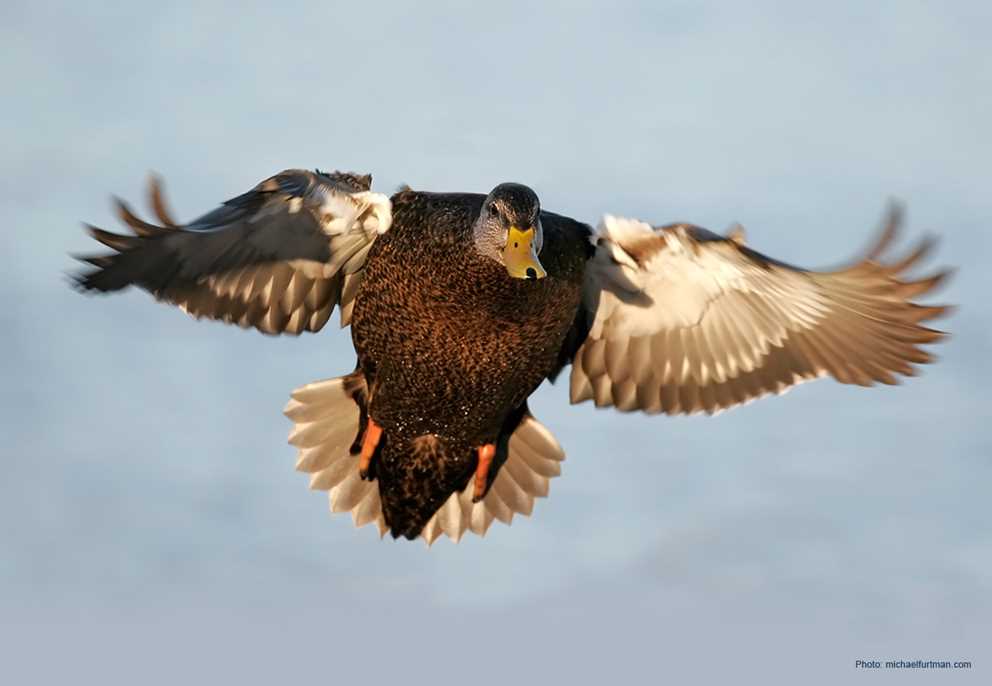Overview
The American Black Duck is a large dabbling duck endemic to North America. Their breeding range is primarily in eastern Canada and the northeastern United States. Breeding birds occur from southern Hudson Bay east to the Maritime Provinces, and south from Maine to coastal North Carolina. Males in alternate plumage are dark, blackish-brown overall, with a pale, grayish head and neck featuring fine, dark streaking that contrasts with the dark back and breast plumage. In flight, the wings appear dark blackish brown with an iridescent bluish-purple to violet speculum that has a black leading edge, and a narrow white trailing edge. The white underwing coverts contrast with the dark body plumage when the bird is in flight. The bill is olive green to yellow, and the legs and feet are reddish orange. Females appear similar to males, but are somewhat paler overall, having a greenish-gray to olive bill with a variable black middle saddle, and duller reddish-orange legs and feet.
Description
Key Identification Features:
- Males in alternate plumage are dark, blackish-brown overall, with a pale, grayish head and neck featuring fine, dark streaking that contrasts with the dark back and breast plumage.
- In flight, the wings appear dark blackish brown with an iridescent bluish-purple to violet speculum.
- The white underwing coverts contrast with the dark body plumage in flight.
- Females are somewhat paler overall.
Male/Female Average Length and Weight
- Weight: Males 2.4–2.9 lbs.; Females 2.1–2.4 lbs.
- Wingspan: Males 10.7–11.5 in.; Females 10.2–10.9 in.
Male Identification:
- Alternate (Breeding) Plumage: Males are dark blackish-brown overall, with a pale grayish head and neck with fine dark streaking that contrasts with the dark back and breast plumage.
- Basic Plumage: Overall dark blackish-brown, similar to alternate plumage.
- In flight, the wings appear dark blackish brown with an iridescent bluish-purple to violet speculum that has a black leading edge, and narrow white trailing edge. The white underwing coverts contrast with the dark body plumage in flight.
- The bill is olive green to yellow, and the legs and feet are reddish-orange.
Female Identification:
- Alternate and Basic Plumage: Females appear similar to males, but are somewhat paler overall. They have a greenish-gray to olive bill with a variable black middle saddle, and duller reddish-orange legs and feet.
In-Flight Identification:
- Dark brown overall with white underwing that is less bright than on Mallards.
Vocalizations:
- Male Calls: make a very reedy “reab” that sounds similar to the male Mallard.
- Female Calls: make a loud “quack” that also sounds similar to that of the female Mallard.
Similar Species:
- Mottled Ducks: Mottled Ducks will have a lighter overall appearance, very limited range overlap, lack of streaking on the buffy throat and neck, and have a blue to bluish-green speculum. Mottled Ducks usually also have a distinct black spot at the base of the bill that American Black Ducks lack entirely. Black Ducks are rare in winter within the range of the Mottled Duck.
- Mexican Ducks: American Black Ducks are much darker than Mexican Ducks. There is no range overlap with the Mexican Duck.
- Mallards: Female Mallards can be similar in appearance to American Black Ducks, but Black Ducks are much darker. Hybrid Mallard-American Black Ducks are fairly common and usually exhibit intermediate characteristics of both species.
Habitat Preferences
- Breeding: American Black Ducks use a diversity of wetland types across their breeding range. Inland, freshwater emergent wetlands and beaver ponds are often used. Birds breeding on the Atlantic Coast use coastal brackish and salt marshes. Nesting habitat varies from forested uplands, grassy islands, and coastal marsh grasslands.
- Migration and Winter: Habitat this time of year also varies, with birds wintering inland making use of a variety of freshwater wetlands and occasionally foraging in waste grain fields. Birds wintering in coastal areas use brackish and salt marshes where they feed heavily on invertebrates.
Foraging Habits and Diet
- American Black Duck in freshwater habitats eat aquatic vegetation and the seeds of various aquatic and emergent plants. In coastal brackish and saltwater wetlands, invertebrates comprise much of their diet. American Black Ducks occasionally feed in uplands and harvested crop fields.
Breeding Habits
- Monogamy: American Black Duck are seasonally monogamous, usually forming pairs during fall and winter.
- Nest Locations: The nest is usually in upland areas, which may be forested, grassy, or in margins of agricultural fields. American Black Ducks will use artificial nest cylinders in some locations.
- Clutch size: Averages 7–11 eggs. The eggs are white to creamy white to pale green buff, elliptical ovate to oval and are 2.3 by 1.7 in. The incubation period is around 26 days.
Migration and Distribution
- Fall Migration: American Black Duck depart breeding areas in September or October, depending on latitude. They begin arriving in wintering regions from October through November.
- Spring migration: Migration begins in February and continues through April, with arrival in breeding areas in late April to May. A relatively small portion of the population is nonmigratory and occupies coastal wetlands from New Jersey south to North Carolina.
Conservation Status
- IUCN Status: Least Concern
- Population Status: In North America, the USFWS Waterfowl Population Status, 2024, estimated a population of 862,000.
- Conservation Concerns: Habitat conversion, primarily the loss and degradation of wetland ecosystems along the Atlantic coast and breeding wetlands throughout eastern Canada, is a primary threat to American Black Ducks. While hybridization with Mallards remains common, new research suggests its risk to American Black Duck populations is not as great as once believed.
- Conservation Focus: Conservation efforts are focused on enhancing, restoring, and protecting wetlands in priority regions of the Atlantic Flyway and eastern Canada.
Harvest Information
- An average of 78,242 American Black Ducks were harvested per season across the US during the 2019 through 2022 hunting seasons.
- Approximately 80 percent of American Black Duck harvest occurs in the Atlantic Flyway. The Mississippi Flyway is responsible for the remaining 20 percent.
- The top three harvest states for American Black Ducks across the 2019–2022 hunting seasons were Maryland (48,620), New York (46,293), and Virginia (35,075).
